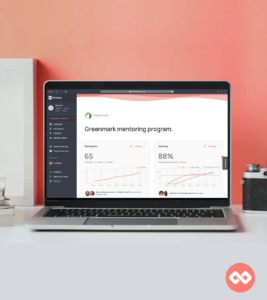When it comes to mentoring program recruitment, there isn’t a one-size-fits-all approach. Different organizations and programs have different needs and goals. Therefore, it’s essential to understand the various recruitment styles and choose the one that best suits your program’s requirements. This will always depend on many factors: your goals, how you want to measure success, or even how much time you have to dedicate to running it.
So in this post, we’ll go through the three recruitment styles, their pros and cons, and how to choose the right one for you.
Let’s get to it.

Always-On / Open Enrollment
Building an always-on culture of mentoring
Always-On programs are consistently open for individuals to join as mentors or mentees. There are no specific enrollment periods, and participants can join the program at any time. Once applications or sign-ups into an always-on program open, the sign-up form remains open indefinitely.
Great For:
- Organisations that want to empower their participants to organise themselves into a match at a time that best fits them.
- Lends itself to Just-in-Time/Flash mentoring – mentees can sign up when they need guidance in particular areas (recent promotion, first presentation to the board, first time leading a company-wide project, etc.) and receive timely guidance from mentors in the program.
Pros:
- New people are always encouraged to enter
- This setup makes it easy to embed mentoring into your organisation’s culture
- It allows for flexibility and ideally ensures a steady stream of participants throughout the year
- This recruitment style makes it easier for individuals to find a mentor or mentee that aligns with their specific needs and interests when they need it instead of being forced into a set timeline that doesn’t work for them
Cons:
- Engagement can drop off without intervention so PCs will need to spend time and effort on marketing throughout the year
- Your participants won’t be on the same timeline
- This can make matching difficult if you plan on matching manually
Pro Tip: If you plan on rrunning an Always-On program, we suggest allowing your participants to make their own mentoring matches. This way, there is no lag time between them signing up and making a start on building those mentoring relationships.
On-Off Recruitment
For PCs who want to prioritise time efficiency
On-Off programs have specific enrollment periods or intakes during which participants can join. These periods may occur once or twice a year, depending on the program’s structure and goals. In these programs, signup forms remain the same but are turned on and off periodically as the program runs.
Great For:
- Time-poor program coordinators with no access to assistance from an internal marketing or comms team. (e.g. program coordinators with big roles in which managing the mentoring program is only a small part)
- This recruitment style can be particularly effective for programs that require a high level of commitment from participants. By having specific enrollment periods, organizations can ensure that participants are fully dedicated and ready to engage in a long-term mentoring relationship.
Pros:
- Having specific enrollment periods allows for better program planning and organization. For example, marketing can be done on a schedule that suits you instead of having to market the program throughout the year.
- This recruitment style is also useful for drumming up excitement for the program and giving those “on the fence” a sense of exclusivity, limited availability, anticipation, and urgency to join before a set closing date as they know when the opportunity to join will arise.
- This also doesn’t necessitate closing the program for those who have joined previous intakes so you can still support existing mentoring relationships.
Cons:
- Your participants won’t be on the same timeline.
- The sense of urgency and pressure for potential participants to join could deter some individuals from participating
- If you choose to match participants manually, you will need to run matching after every intake period.
Cohorts
Get your participants on the same journey
Cohorts are groups of individuals who join the program at the same time and progress through the mentoring journey together. These programs open applications for a set timeline, close applications, and start matching. The program then runs with the current participants until it closes, then starts back up again with a different cohort.
Great For:
- Industry or membership organisations with dedicated intakes
- Organisations that can’t afford or don’t have the time to run multiple programs or handle a large number of participants at once.
- Programs that have their own resources and events and would like all participants to be on a linear journey.
Pros
- This setup enables you to design a whole program for your cohorts because they’re all on the same journey. This means it allows for more structured and focused interaction as mentorship activities can be tailored specifically for each cohort.
- Cohorts create a sense of community and belonging among participants, as they all go through the program on the same timeline. This allows organizations to foster a supportive and collaborative environment within the program where participants can learn from each other’s experiences.
- Cohorts can also provide a built-in support system for participants, as they can lean on their peers for guidance and encouragement throughout the mentoring journey.
- This also gives you a good cadence for your program marketing
Cons
- This requires opening and closing a program, and therefore formally closing the mentoring relationships in the program, for every cohort. Participants can choose to maintain existing relationships informally, but the formal relationship will be closed as the program closes.
- If you plan to scale, keep in mind that building and managing multiple cohorts may require additional resources and time
At nib Group, they run their mentoring program in cohorts. We had a chat with award-winning program coordinator Kate Lloyd where she shared how they went about launching the program and how they continue to recruit participants in this way.
To learn more about the nib mentoring program, access the full fireside chat here:
How to Identify the Right Recruitment Style for Your Program
As you can see, there are pros and cons to each mentoring program recruitment style. So here are a few factors to consider when choosing what to go with:
- Program Goals: What are the specific objectives and outcomes you aim to achieve through your mentoring program? The recruitment style should align with these goals.
- Participant Preferences: Understand your target audience and their preferences. Are they more likely to join an always-on program, or do they prefer a structured cohort experience?
- Resources Available: Assess the resources, both human and financial, that you have available to support your mentoring program recruitment style. Some styles may require more resources than others.
- Program Size: Consider the size of your program. Are you targeting a large number of participants, or do you have a smaller, more specialized audience? The recruitment style should accommodate the program size.
- Program Duration: Think about the duration of your program. Is it a long-term program that runs indefinitely, or does it have a fixed start and end date? This will impact the suitability of different recruitment styles.
By carefully considering these factors, you can identify the right recruitment style for your mentoring program. Remember, there isn’t a one-size-fits-all approach, so it’s crucial to choose a style that aligns with your program’s unique needs and goals.
For more on recruitment styles and tips on how to make these recruitment styles work for your program, head to the Mentorloop Academy where our team of mentoring experts share best practices for program management learned from running hundreds of successful programs through the years.
You can also download our sample program timelines to get an idea of what 12 months of running a mentoring program might look like.

Ready to explore what kind of program is right for you? Let us guide you in building your best mentoring program yet!




